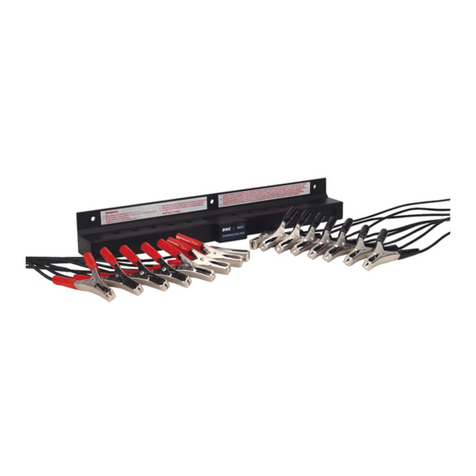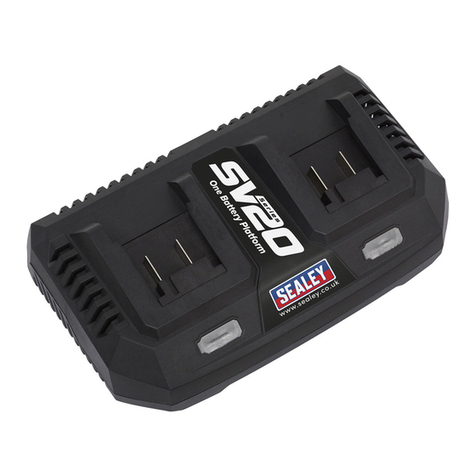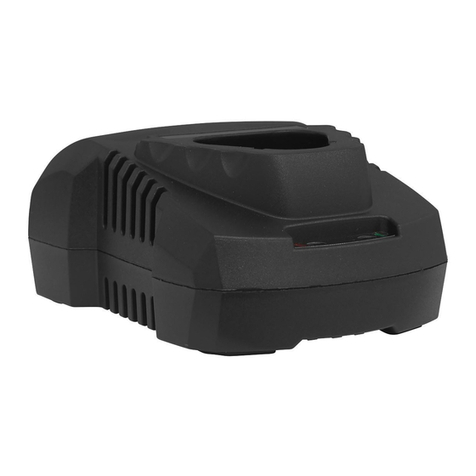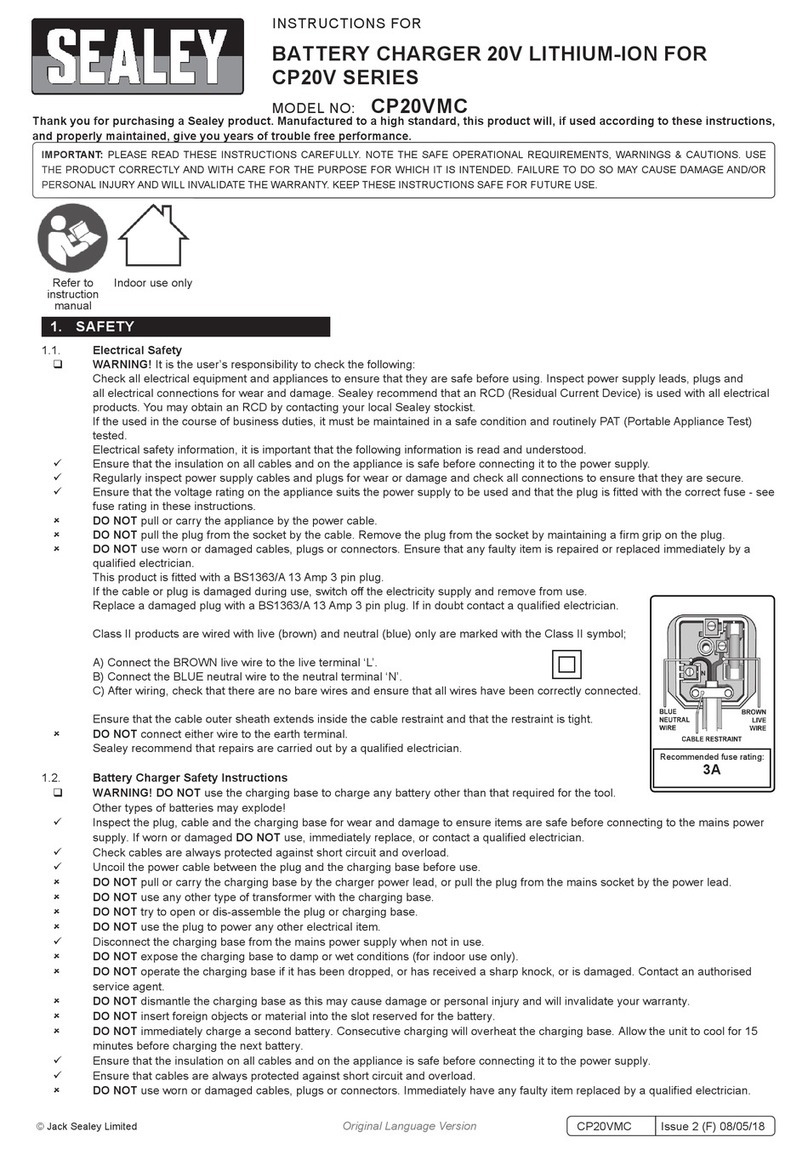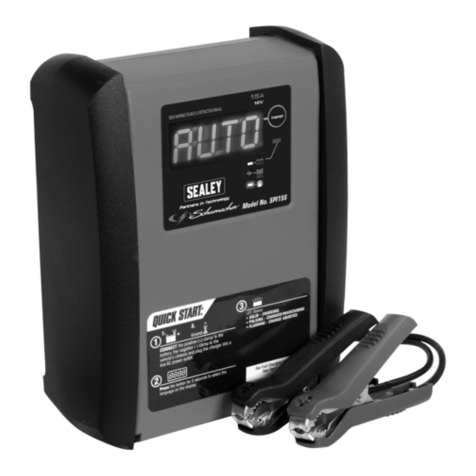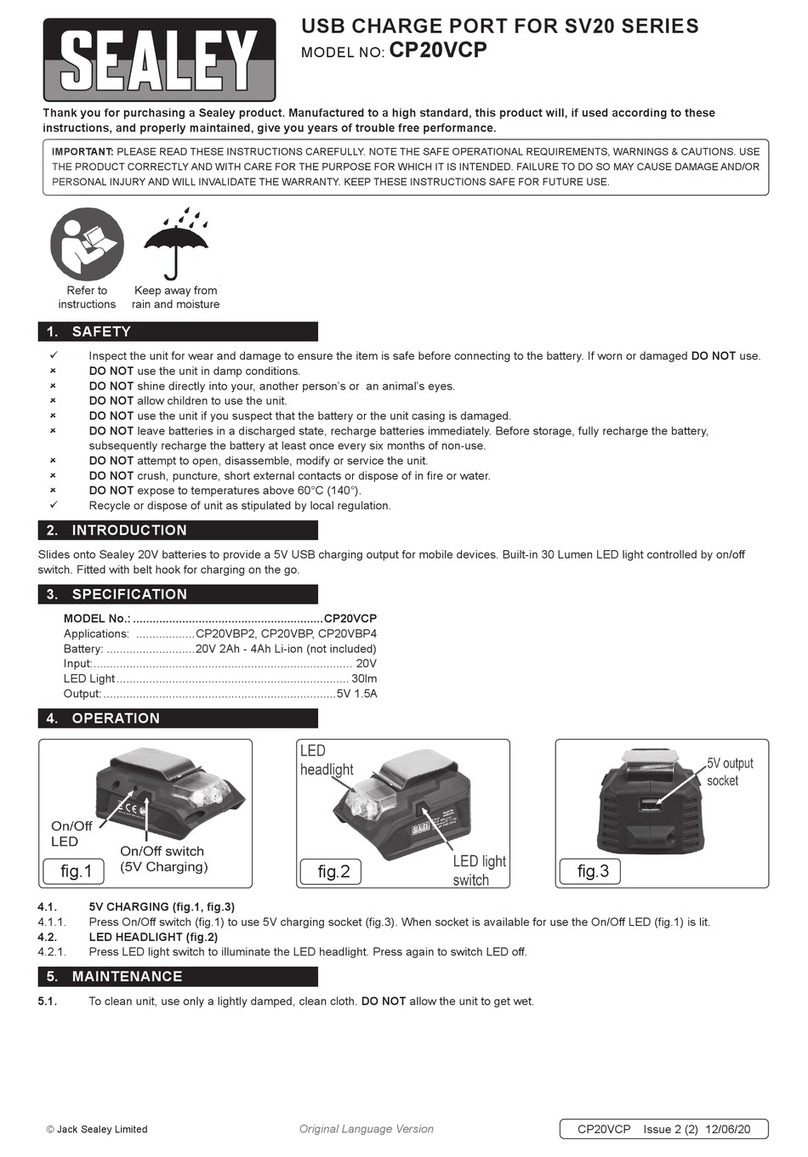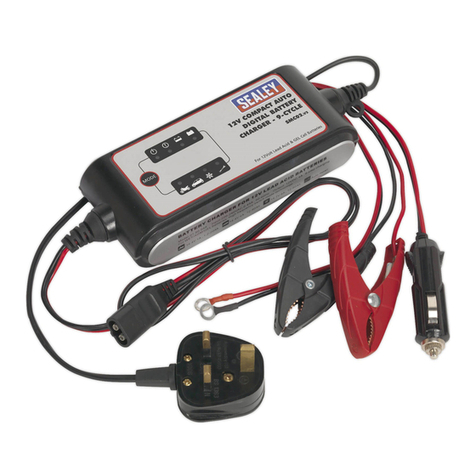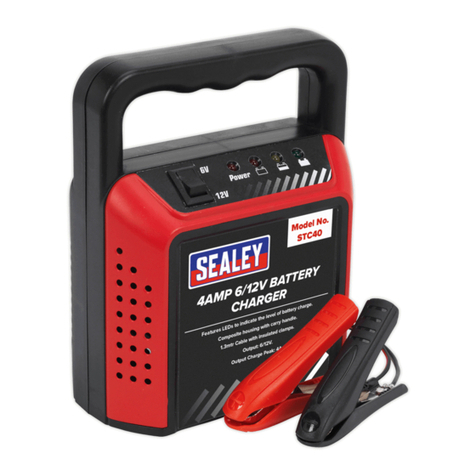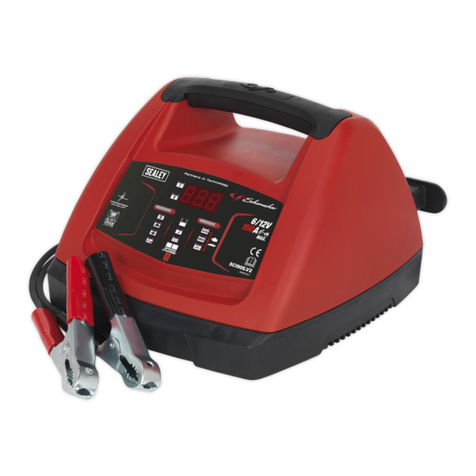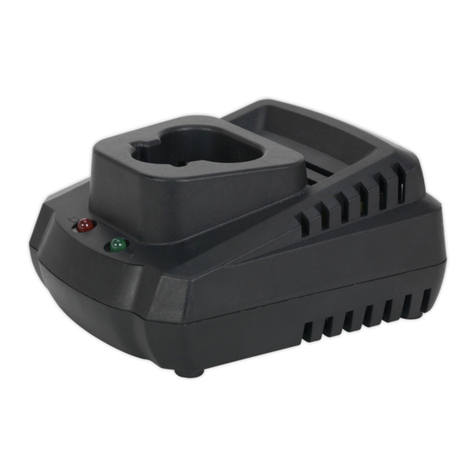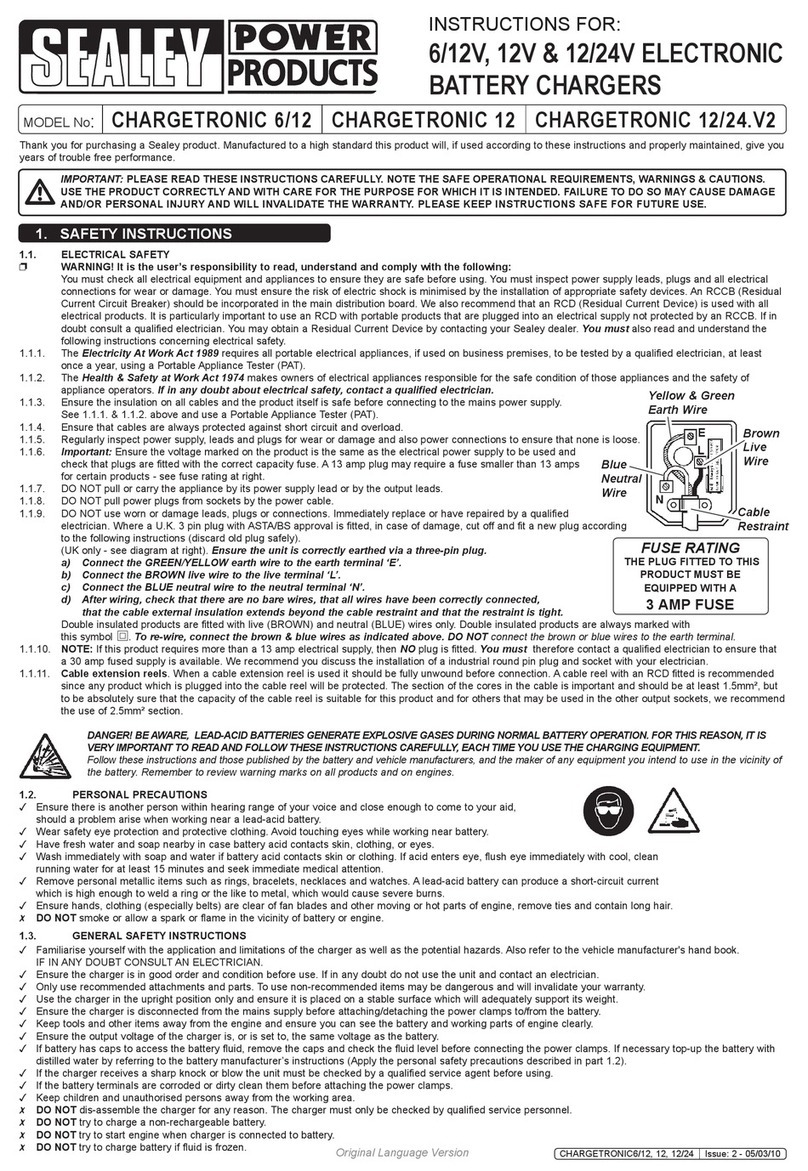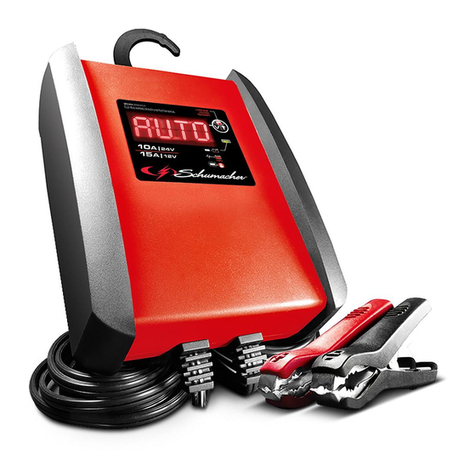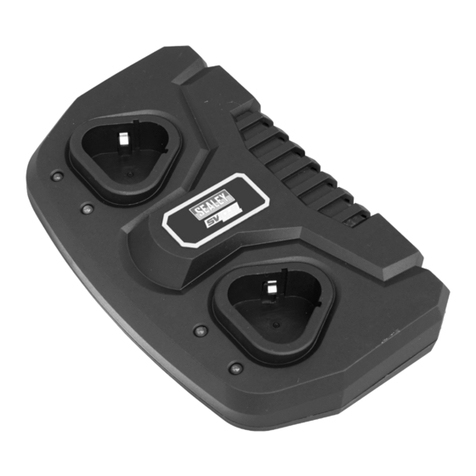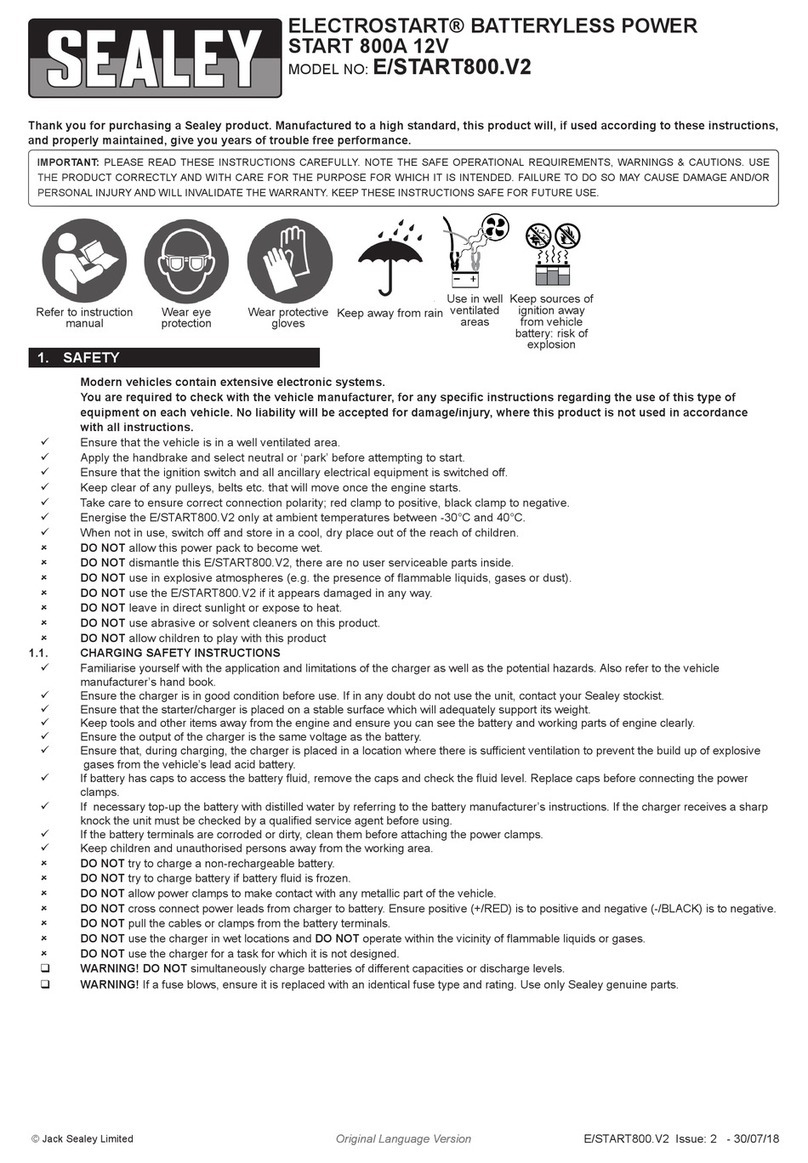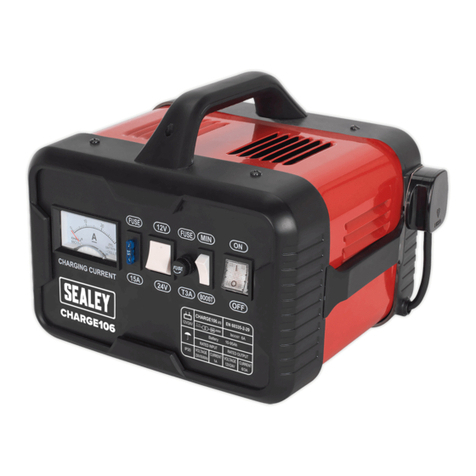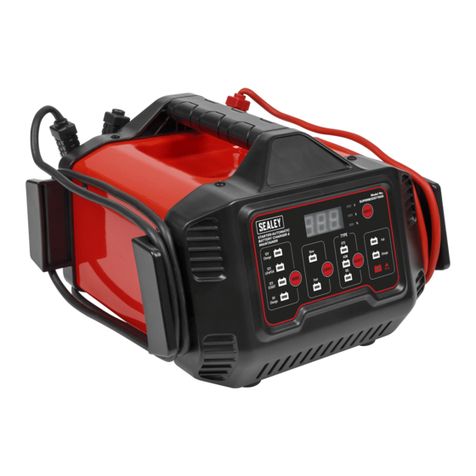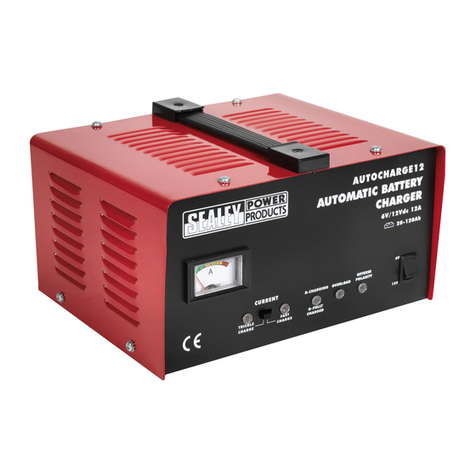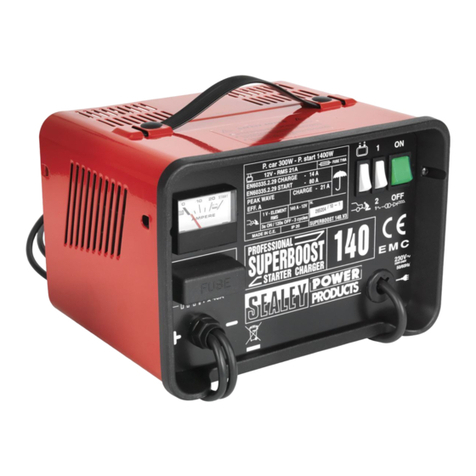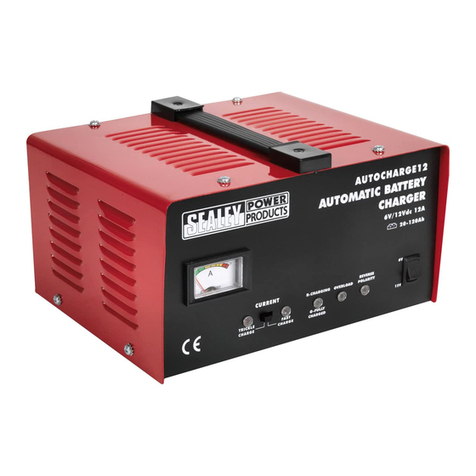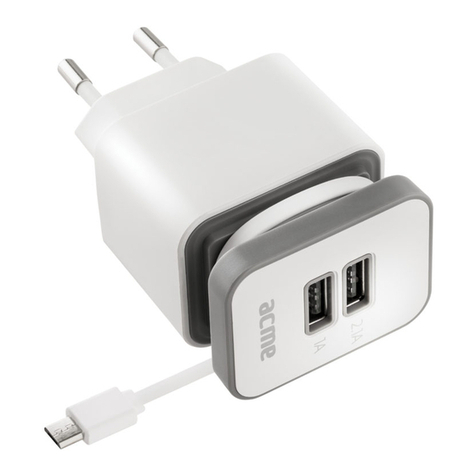
1.5. GENERAL SAFETY INSTRUCTIONS
3Familiarise yourself with the application, limitations and potential hazards relating to starter/chargers. Also refer to the vehicle manufacturers
hand book. IF IN ANY DOUBT CONSULT AN ELECTRICIAN.
3Ensure the starter/charger is in good order and condition before use. If in any doubt do not use the unit and contact an electrician.
3Only use recommended attachments and parts. To use non-recommended items may be dangerous and will invalidate your warranty.
3Use the starter/charger in the horizontal position only and ensure it is placed on a stable surface which will adequately support the weight.
3Check the Off LED to ensure the starter/charger is registering Off before handling the power clamps.
3Ensure the starter/charger is Off before attaching/detaching the power clamps to/from the battery.
3Keep tools and other items away from the engine and ensure you can see the battery and moving parts of the engine clearly.
3Ensure the voltage on the starter/charger is set to the same voltage as the battery.
3If battery has caps to access the battery fluid, remove the caps and check the fluid level before connecting the power clamps. If necessary top-up
the battery with distilled water by referring to the battery manufacturers instructions (apply the personal safety precautions described in para. 1.3).
3The cables may become hot with excessive use. If so, allow a few minutes for them to cool down before attempting to re-use.
3If the starter/charger receives a sharp knock or blow the unit must be checked by a qualified service agent before using.
3If the battery terminals are corroded or dirty clean them before attaching the power clamps.
3Keep children and unauthorised persons away from the work area.
7DO NOT dis-assemble the starter/charger for any reason. The starter/charger must only be checked by qualified service personnel.
7DO NOT try to charge a non-rechargeable battery.
7DO NOT try to start engine, or to charge battery, if battery is frozen.
pWARNING! To prevent the risk of sparking, short circuit and possible explosion DO NOT drop metal tools in the battery area, or allow them
to touch the battery terminals.
7DO NOT allow power clamps to touch each other or to make contact with any metallic parts of the vehicle.
7DO NOT cross connect power leads from starter/charger to battery. Ensure positive (+) (RED) is to positive and negative (-) BLACK is to negative.
If symbols cannot be distinguished, remember that the negative terminal is the one directly connected to the vehicle bodywork.
7DO NOT pull the cables or clamps from the battery terminals and DO NOT remove power clamps while the starter/charger is On.
7DO NOT use the starter/charger outdoors, or in damp or wet locations and DO NOT operate within the vicinity of flammable liquids or gases.
7DO NOT use starter/charger inside vehicle or inside engine compartment. Ensure there is sufficient ventilation and do not cover or obstruct
starter/charger ventilation louvres.
7DO NOT use this product to perform a task for which it is not designed.
pWARNING! Simultaneous charging of batteries is possible but must be done with great caution by a qualified person. Contact your
Sealey dealer for information and accessories. DO NOT charge in series two batteries of differing type, capacity, or levels of discharge.
pWARNING! If a fuse blows, ensure it is replaced with an identical fuse type and rating.
3When not in use, store the starter/charger carefully in a safe, dry, childproof location. ,
2. SPECIFICATIONS
MODEL NO: . . . . . . . . . . . . . . .S/START520/1.V3 . . .S/START620/1.V3
Output 12V Charge Peak (EN) . . . . . . . .75A (50A) . . .105A (60A) (70A)
Output 24V Charge Peak (EN) . . . . . . . .75A (50A) . . .105A (60A) (70A)
Output 12V Start Peak (EN) . . . . . . . .450A (300A) . . . . . . .540A (360A)
Output 24V Start Peak (EN) . . . . . . . .450A (300A) . . . . . . .540A (360A)
Input-Charge . . . . . . . . . . . . . . . . . . . . . . .6A/12A . . . . . . . . . . .9A/16A
Input-Start . . . . . . . . . . . . . . . . . . . . . . . . . . . .30A . . . . . . . . . . . . . .30A
Input . . . . . . . . . . . . . . . . . . . . . . . . . . . . . . .230V . . . . . . . . . . . . .230V
Output . . . . . . . . . . . . . . . . . . . . . . . . . . .12V/24V . . . . . . . . . .12V/24V
Fuse ref. (quantity) . . . . . . . . . . . .120/121003 (2) . . . . .120/121003 (2)
Pack of 20 fuses . . . . . . . . . . . . . . . . .120/802029 . . . . . . . .120/802029
1.4. PERSONAL PRECAUTIONS
3Ensure there is another person within hearing range of your voice, or close enough
to come to your aid, should a problem arise when working near a lead-acid battery.
3Wear safety eye protection and protective clothing. Avoid touching eyes while working near battery.
3Have fresh water and soap nearby in case battery acid contacts skin, clothing, or eyes.
3Wash immediately with soap and water if battery acid contacts skin or clothing. If acid enters eye, flush eye immediately with cool, clean
running water for at least 15 minutes and seek immediate medical attention.
3Remove personal metallic items such as rings, bracelets, necklaces and watches. A lead-acid battery can produce a short-circuit current
high enough to weld a ring or the like to metal, which may cause severe burns.
3Ensure hands, clothing (especially belts) are clear of fan blades and other moving or hot parts of engine, remove ties and contain long hair.
7DO NOT smoke or allow a spark or flame in the vicinity of battery or engine.
DANGER! BE AWARE, LEAD-ACID BATTERIES GENERATE EXPLOSIVE GASES DURING NORMAL BATTERY OPERATION. FOR THIS REASON, IT IS
VERY IMPORTANT TO READ AND FOLLOW THESE INSTRUCTIONS CAREFULLY, EACH TIME YOU USE THE CHARGING EQUIPMENT.
Follow these instructions and those published by the battery and vehicle manufacturers and the manufacturer of any equipment you
intend to use in the vicinity of the battery. Remember to review warning marks on all products and on engines.
MODEL NO: . . . . . . . . . . . . . . . . . . . . .SUPERSTART 1020.V2
Volts input . . . . . . . . . . . . . . . . . . . . . . . . . . . . . . . . .415V 3PH
Volts output . . . . . . . . . . . . . . . . . . . . . . . . . . . . . . . . . .12V/24V
Output 12V Charge Peak (EN) . . . . . . . . . . . . .120A(80A)(90A)
Output 24V Charge Peak (EN) . . . . . . . . . . . . .120A(80A)(90A)
Output 12V Start Peak (EN) . . . . . . . . . . . . . . . . . . .960A(640A)
Output 24V Start Peak ;(EN) . . . . . . . . . . . . . . . . . .960A(640A)
Input Charge . . . . . . . . . . . . . . . . . . . . . . . . . . . . . . . . . .4A/8A
Input Start . . . . . . . . . . . . . . . . . . . . . . . . . . . . . . . . . . . . . .30A
Fuse Ref & quantity . . . . . . . . . . . . . . . . . . . . . .120/122452 (3)
Pack of 10 fuses . . . . . . . . . . . . . . . . . . . . . . . . . . .120/802131
3. OPERATING INSTRUCTIONS
3.1. PREPARATION It is important to correctly prepare for charging - follow Section 1 safety requirements and, especially when
charging battery in situ, any vehicle manufacturer's instructions. Check that capacity of battery is compatible with charger output.
3.1.1. Check battery to ensure the NEGATIVE & POSITIVE terminals are clearly identifiable before removing the battery from the vehicle.
3.1.2. Disconnect and remove the battery from the vehicle and place in an appropriate safe area ready for charging.
3.1.3. Remove the battery electrolyte cover or caps to allow the gases produced by charging to escape.
3.1.4. Check the electrolyte fluid level in the battery is above the plates. If not, add distilled water to cover them by 5 - 10mm.
DO NOT touch the battery fluid as it is corrosive.
3.1.5. The correct charging status of the battery may be determined by use of a hydrometer which measures the specific density of the electrolyte
The following information indicates kg/l at 20oC: 1.28 = Fully charged 1.21 = Half charged 1.14 = Fully discharged battery.
p
p
WARNING! Be cautious and vigilant as the electrolyte is highly corrosive sulphuric acid.
p
p
WARNING! Ensure you have read and understand all safety instructions before using the charger.
Superstart 520/1.V3, 620/1.V3,1020.V2 - 0051 - (3) - 24/06/02
